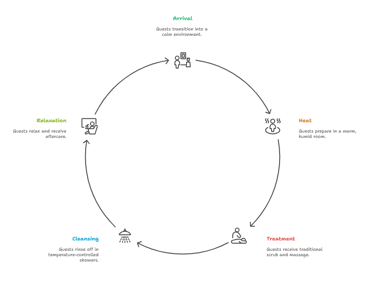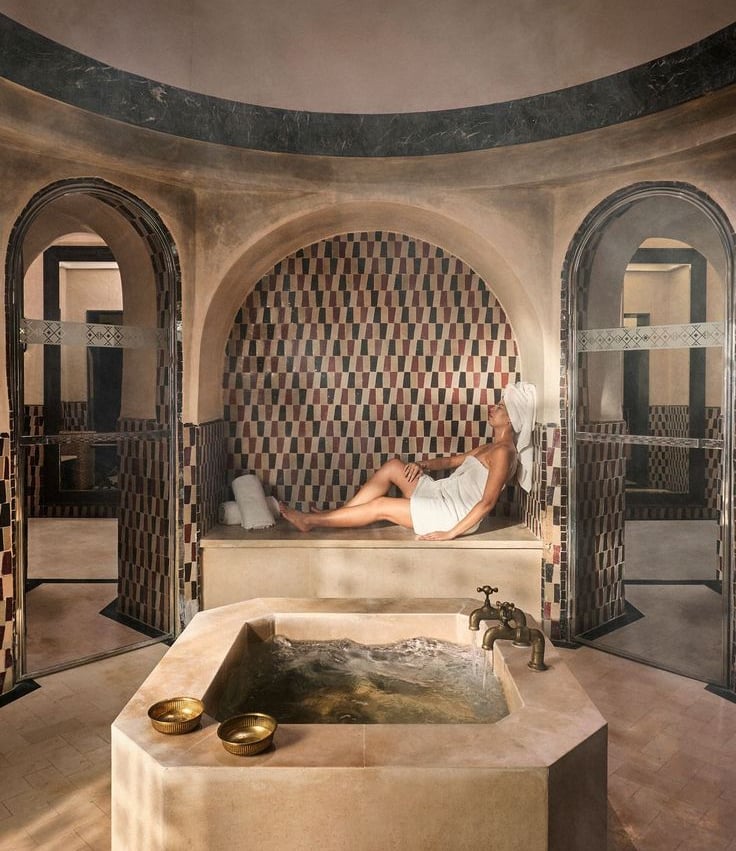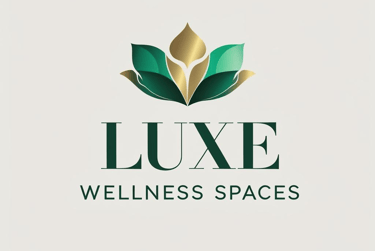Luxury Hammam Design: Why Ritual Is Your Top ROI Driver
Unlock the true ROI of your luxury hammam design. Learn why the ritual, not just the room, drives profit. Elevate your spa's performance.
Daryn Berriman
10/31/20255 min read
That multi-million dollar hammam is beautiful. The marble is flawless, the lighting is atmospheric, and it looks perfect in your resort's photo gallery. There's just one problem: it's almost always empty.
This is the most common and costly story in luxury spa development. The secret to luxury hammam design isn't just in the stone, steam, or architecture. The true financial return is unlocked by designing the ritual.
The problem is that most operators treat the hammam as a passive amenity-a hot room guests can use for 10 minutes. This approach delivers almost no ROI. A performing hammam, however, is a high-margin, bookable, staff-led experience. It's a 90-minute journey that commands a premium price, drives word-of-mouth, and becomes a signature element of your brand.
By shifting your focus from passive space to active experience, you transform a cost center into a powerful revenue stream.
What "Ritual-First" Design Actually Means
A traditional hammam journey is pure theatre. It's a choreographed sequence of heating, scrubbing, cleansing, and relaxing. This ritual cannot be an afterthought; the physical space must be built to serve this exact flow.
"Ritual-first" design means mapping the entire user journey and the corresponding staff workflow before the first tile is specified. It's the core of how we merge immersive user experience with operational excellence. It's the difference between a guest wandering into a steam room and a guest paying $350 for a "Signature Turkish Bath Experience."
The 5 Stages of a Profitable Hammam Journey
To build a hammam that delivers commercial returns, your design must accommodate five distinct stages.
1. The Arrival (Decompression)
This is the transition from the "outside" world. The design must be calm, quiet, and intuitive.
Guest Experience: A clear, private changing area, a place for slippers and robes, a quiet bench, and perhaps a warm tea.
Operational Design: This area must be separate from the "wet" zones. It requires simple logistics for staff to reset the space discreetly.
2. The Heat (Preparation)
The guest enters the first warm room. This isn't the main event; it's the preparation. The goal is to heat the body slowly and begin the mental release.
Guest Experience: A warm, humid room (the göbek taşı, or heated stone, is the centerpiece) with radiant heat.
Operational Design: The design must allow for easy cleaning. Surfaces must be non-porous and durable, but feel like "quiet luxury".
3. The Treatment (The Core Service)
This is the main event and your primary revenue driver. A therapist performs the traditional scrub (kese) and foam massage.
Guest Experience: This is an intimate, vulnerable moment. The guest is on a heated stone or bench. Lighting must be soft and indirect.
Operational Design: This is where most designs fail. The space needs a dedicated, heated treatment slab, excellent drainage, task lighting for the therapist, and storage for bowls, soaps, and linens-all within arm's reach but hidden from the guest's view.
4. The Cleansing (The Transition)
After the vigorous treatment, the guest is rinsed. This is a dramatic, sensory transition from heat and activity to cleansing and calm.
Guest Experience: This often involves multiple temperature-controlled showers or taps, from warm to cool.
Operational Design: Water pressure, temperature control, and drainage are critical. The workflow must allow the therapist to manage this cleansing without leaving the guest or breaking the experience.
5. The Relaxation (Aftercare & Upsell)
The journey isn't over. The guest is now moved to a final, dry relaxation lounge.
Guest Experience: A comfortable lounger, a warm towel, and a final offering of tea, water, or a light snack.
Operational Design: This is your "golden minute" for retention. This space must be serviced by staff, allowing them to check on the guest and (if appropriate) recommend products or re-booking. It integrates the spa experience with the hotel's wider F&B and retail strategy.


The Costly Mistake Most Hotels Make with Hammam Design
The most expensive mistake is designing for aesthetics first and operations last. We've seen projects where the treatment slab is too far from the water source, forcing therapists to walk across a wet floor with heavy bowls. We've seen "hidden" storage so well-hidden that staff can't access it, so they end up leaving plastic carts in a marble room.
These small operational frictions destroy the "effortless" luxury feel. A therapist who is stressed, uncomfortable, or inefficient cannot deliver a premium, relaxing experience. This is why our process starts with workflow design and user-journey mapping, ensuring the space performs for guests and staff alike.
The Counter-Intuitive Truth: Your Hammam Isn't a Room
Your hammam isn't a room. It's a high-margin, low-capacity theatre. You are not selling access to a steam room. You are selling a 90-minute, $350 ticket to an unforgettable, story-driven performance.
When you see it as a "show," the entire investment strategy changes. You stop worrying about maximizing capacity and start obsessing over the quality of the script (the ritual) and the design of the stage (the space). The ROI comes from this exclusive, high-touch, memorable performance-not from volume.
Turn Your Wellness Space into a Strategic Asset
A well-designed hammam is more than a line item on your spa menu; it's a statement. It signals a deep commitment to authentic, immersive wellness. But it must be designed with a clear focus on operational excellence and commercial performance.
Don't just build a beautiful room. Build an experience that delivers real guest delight and measurable asset uplift. Our philosophy is "quiet luxury and commercial performance". If you're ready to design a wellness space that truly performs, we should talk.
Contact us directly to discuss your specific development or repositioning challenge. The wellness hospitality landscape is shifting. The question is whether you'll lead that shift or respond to it.


FAQs (People Also Ask)
1. What is the difference between a hammam and a sauna? A sauna provides dry heat (low humidity) at very high temperatures, originating from Scandinavian traditions. A hammam, or Turkish bath, provides high-humidity, wet heat at a lower, more bearable temperature. The hammam experience is also an active, multi-step ritual involving steam, scrubbing, and washing, whereas a sauna is typically a passive experience.
2. What are the key design elements of a luxury hammam? A luxury hammam design includes a sequence of spaces: a dry changing and relaxation area, a warm room (tepidarium) for acclimating, and a hot, humid room (caldarium) with a central heated stone (göbek taşı) for treatments. Key elements include radiant (not forced air) heat, extensive use of non-porous stone or marble, specialized drainage, and atmospheric, waterproof lighting.
3. How do you calculate the ROI on a hammam? The ROI on a hammam should not be calculated as a passive amenity. Instead, it's calculated as a bookable service. You must model the revenue from signature hammam rituals (e.g., [Price per ritual] x [Number of therapists] x [Daily capacity]) minus the direct operational costs (staff, products, laundry, and utilities). A well-designed hammam transforms this from a cost center into a high-margin profit center.
4. What is a traditional hammam ritual? A traditional ritual is a journey. It starts with relaxing in a warm room to open the pores, followed by a vigorous full-body exfoliation by a therapist using a "kese" mitt. After the scrub, the therapist covers the guest in a cloud of soap foam for a massage, followed by a thorough rinsing with warm and cool water. The ritual concludes in a relaxation lounge with tea or water.
Further reading on our blog: 'African Bush Lodges Redefine Wellness'
Learn more about the blog author and our principal consultant at Luxe Wellness Spaces.
Explore our Spa & Wellness Consultancy to scope project phases and services.
See how we structure Fitness and Leisure concepts before you commit to equipment.
Learn why Luxe Wellness Spaces blends design, operations, and growth under one roof.
View a Concept-to-Launch case study that hit break-even in 90 days.


